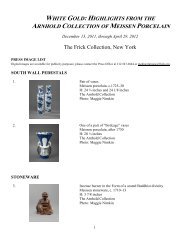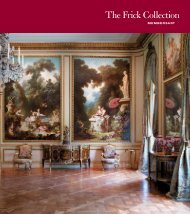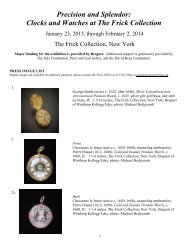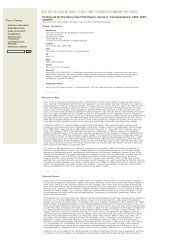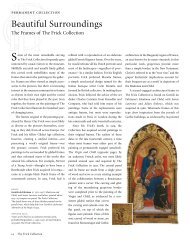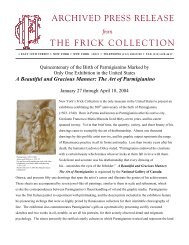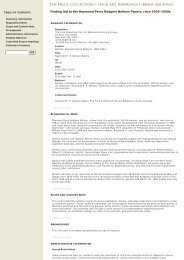Press Release - The Frick Collection
Press Release - The Frick Collection
Press Release - The Frick Collection
You also want an ePaper? Increase the reach of your titles
YUMPU automatically turns print PDFs into web optimized ePapers that Google loves.
ARCHIVED PRESS RELEASE<br />
from<br />
THE FRICK COLLECTION<br />
1 EAST 70TH STREET • NEW YORK • NEW YORK 10021 • TELEPHONE (212) 288-0700 • FAX (212) 628-4417<br />
FIRST NORTH AMERICAN EXHIBITION TO FOCUS ON CELEBRATED<br />
EIGHTEENTH-CENTURY COURT PAINTER<br />
JEAN-ÉTIENNE LIOTARD (1702–1789): SWISS MASTER<br />
June 13, 2006, through September 17, 2006<br />
A prolific pastelist, painter, and miniaturist who traveled throughout Europe and the<br />
Near East, Jean-Étienne Liotard is one of the most fascinating, yet least familiar, artists<br />
of the eighteenth century. Although Liotard enjoyed an international reputation in his<br />
own time, today his work is relatively little known outside his native Switzerland, even<br />
among specialists. <strong>The</strong> <strong>Frick</strong> <strong>Collection</strong> is pleased to present the first monographic<br />
exhibition in North America devoted to this intriguing artist. Inspired by Lore<br />
Heinemann’s generous 1997 bequest, Trompe l’Oeil, the exhibition Jean-Étienne<br />
Liotard (1702–1789): Swiss Master will present more than fifty paintings, drawings,<br />
Jean-Étienne Liotard, Liotard Laughing, miniatures, and engravings from the Musées d’art et d’histoire in Geneva, the world’s<br />
c.1770, Oil on canvas, Musées d’Art et<br />
d’Histoire, Département des Beaux-Arts photo:<br />
Bettina Jacot-Descombes<br />
most extensive repository of Liotard’s oeuvre, together with pastels and other works<br />
from Swiss private collections. As few of these masterpieces have been seen in the<br />
United States, the exhibition will provide a singular opportunity for viewers to become more familiar with Liotard’s<br />
remarkable achievements. Its exclusive presentation in New York, through September 17, 2006, will be<br />
accompanied by the first general introductory publication on the artist in English as well as free public lectures and<br />
related concert programs.<br />
Jean-Étienne Liotard (1702—1789): Swiss Master has been organized by Chief Curator Colin B. Bailey with the<br />
assistance of Kristel Smentek, Andrew W. Mellon Curatorial Fellow. Its presentation is made possible, in part,<br />
through the generous support of Margot and Jerry Bogert; Melvin R. Seiden in honor of Jean A. Bonna and Inez<br />
and Yves Oltramare, with additional support from Inez and Yves Oltramare; Jean A. Bonna; Pro Helvetia, Arts
Council of Switzerland; <strong>The</strong> Helen Clay <strong>Frick</strong> Foundation; and the Fellows of <strong>The</strong> <strong>Frick</strong> <strong>Collection</strong>. Transportation<br />
costs have been generously underwritten by Swiss International Air Lines. <strong>The</strong> catalogue is made possible, in part,<br />
by Lawrence and Julie Salander.<br />
Comments Chief Curator Colin B. Bailey, “<strong>The</strong> <strong>Frick</strong> <strong>Collection</strong> is one of the very few museums outside Geneva to<br />
own a masterpiece in oil by Liotard, and it is his Trompe l’Oeil of 1771 bequeathed by Lore Heinemann in 1997<br />
that inspired the current exhibition. Liotard is one of the most original —and eccentric—of all eighteenth-century<br />
artists, whose fame during his lifetime spread from the courts of Europe as far afield as Constantinople, and even to<br />
the colonies in Boston, Massachusetts. Thanks, above all, to the extraordinary generosity of the Musées d’art et<br />
d’histoire in Geneva—which boast the foremost holdings of works by Liotard in the world—a New York audience<br />
will have the opportunity to discover this Swiss master in all the media in which he excelled: from paintings in oil<br />
and pastel, to drawings in three crayon, engravings, and miniatures.”<br />
When Liotard exhibited the <strong>Frick</strong>’s Trompe l’Oeil in London in 1773,<br />
he described it as a “deceptio visus” (visual deception). With its<br />
illusionistic plaster reliefs suspended from screws and drawings<br />
adhered with sealing wax to a simulated pine panel, Trompe l’Oeil is<br />
both a delightful piece of visual trickery and a masterful demonstration<br />
of the artist’s mimetic powers. Although Liotard began painting<br />
trompe l’oeil images relatively late in his career, the goal of exact<br />
imitation evinced in this small work characterizes the artist’s oeuvre as Liotard, Trompe l’Oeil, 1771, Oil on silk transferred to canvas, <strong>The</strong> <strong>Frick</strong><br />
<strong>Collection</strong>, bequeathed by Lore Heinemann in memory of her husband,<br />
a whole. To his admirers, Liotard was the “painter of truth.” Whether Dr. Rudolph J. Heinemann, 1997, photo: Richard di Liberto<br />
executed in oil, pastel, or in graphic media, his portraits and genre scenes are so closely observed and so startlingly<br />
direct that one can’t help but marvel at their realism. Indeed, Liotard was unsparing in his depiction of his sitters,<br />
including himself (see front page), avoiding the flattery and embellishment that characterized the art of his<br />
colleagues. He also avoided the “touche,” or painterly touches, and visible brushstrokes of his contemporaries,<br />
railing in his Treatise on the Principles and Rules of Painting (1781) that, since one did not see such flourishes in<br />
nature, they had no place in art. While his ideas accorded with the tenets of Enlightenment empiricism, they put<br />
him at odds with the artistic establishment. His insistence on painting only what he saw may have given some of<br />
his sitters pause as well; according to one observer, Liotard’s penchant for the real over the artificial meant that<br />
many women of “middling beauty” trembled at the thought of having him paint their portraits. It was the veracity<br />
of his art, however, that was the foundation of his great success and his international reputation.<br />
Born in Geneva in 1702, Liotard was the son of a French Huguenot family that fled to Geneva following the<br />
Revocation of the Edict of Nantes in 1685, which rescinded the religious and civil rights of Protestants living in<br />
France. He began his artistic training with the Genevan miniaturist Daniel Gardelle (1673–1753), then moved to<br />
2
Paris to apprentice with the portraitist, miniaturist, and printmaker Jean-Baptiste Massé (1687–1767). By 1726,<br />
Liotard had left his master’s studio and was active independently in Paris, executing miniatures, oil paintings, and<br />
etchings and experimenting with color printmaking.<br />
Liotard’s trip to Paris was only the first of many voyages he undertook to further his career. After an unsuccessful<br />
bid to enter the French Royal Academy in 1735, he left Paris for Naples at the invitation of the marquis de<br />
Puysieux, the newly appointed ambassador of the French court to the Kingdom of the Two Sicilies. From Naples,<br />
Liotard traveled to Rome, where he executed portraits of such prestigious sitters as Pope Clement XII (now lost)<br />
and the family of James Stuart, pretender to the English throne. Liotard’s very fine miniature of 1738 of the Old<br />
Pretender’s sons, Prince Henry Benedict Stuart and Prince Charles Edward Stuart (Bonnie Prince Charlie), will be<br />
included in the <strong>Frick</strong> exhibition. Liotard’s first extant works in pastel—a medium in which he was to excel—date<br />
from his Roman sojourn as well. While in the Eternal City, Liotard met two English Grand Tourists, the Earl of<br />
Sandwich and William Ponsonby (later the Earl of Bessborough), who invited him to accompany them to the Greek<br />
islands and to Constantinople. This visit to the Ottoman capital was to be the defining moment of Liotard’s career.<br />
LIOTARD BECOMES “LE PEINTRE TURC”<br />
Liotard arrived in Constantinople in May or June of 1738, and the city so captivated him that he remained there<br />
long after the departure of his English patrons. His decision may have been prompted by the recent death of Jean-<br />
Baptiste Vanmour (1671–1737), the city’s resident Western painter. During Liotard’s four years in Constantinople,<br />
he worked assiduously, compiling a repertoire of highly detailed drawings of men and women in sumptuous<br />
Turkish dress, posed in recognizably Turkish interiors, that would serve him as models throughout his career. He<br />
established himself as a portraitist to foreigners, receiving commissions for pastels and<br />
oil paintings from Western diplomats, merchants, and travelers, many of whom chose to<br />
be represented in Turkish costume. Like some of his Western sitters, Liotard adopted<br />
Turkish dress—a long robe and loose pants gathered at the ankles complemented by a<br />
fezlike cap; unlike his patrons, he continued to wear these garments for the rest of his<br />
life, some fifty years after he had left the Levant. Liotard’s exotic appearance was made<br />
even more extraordinary by the long beard he grew in imitation of the local nobility of<br />
Jassy, Moldavia (present-day Romania), a court he visited in 1742. Although Liotard<br />
remained in Jassy for less than a year, he retained his distinctive beard until his marriage<br />
in 1756.<br />
Liotard, Presumed Portrait of Maria<br />
<strong>The</strong>resa (1717-1780) in Turkish Costume,<br />
1743-1745, Watercolor and gouache on<br />
vellum, 7.3 x 5.4 (2 7/8 x 2 1/8), Musée de<br />
l’Horlogerie et de l’Émaillerie, photo:<br />
Maurice Aeschimann<br />
To sport facial hair of any sort was unusual in eighteenth-century Europe, and when Liotard arrived in Vienna in<br />
1743 from Moldavia, his hirsute appearance and Turkish clothing caused a sensation (as they did in every European<br />
city he was to visit). In Vienna, he attracted the attention of the Empress Maria <strong>The</strong>resa, who became his lifelong<br />
3
patron. (In 1763, she became the godmother of Liotard’s second daughter, her namesake, Marie-Thérèse.) Liotard<br />
had brought Turkish costumes with him from Constantinople, and several of his sitters are known to have worn<br />
them for their portraits. An exquisite miniature of a woman in Turkish dress believed to be Maria <strong>The</strong>resa suggests<br />
that even the empress herself may have donned them for a likeness by “le peintre turc,” as he had become known.<br />
THRIVING IN PARIS, LONDON, THE NETHERLANDS, GENEVA<br />
From Vienna, Liotard traveled to Venice, Milan, Frankfurt, Darmstadt, Geneva, and Lyons, arriving back in Paris<br />
in 1748. Despite the hostility of the French artistic establishment toward him and<br />
his lack of any official affiliation, Liotard thrived in Paris, executing and exhibiting<br />
portraits, genre scenes, and Turkish subjects. Among his sitters were members of<br />
the French royal family, important figures in the French court, and numerous<br />
English visitors to Paris, including the actor David Garrick, who remarked on the<br />
striking likenesses of Liotard’s portraits. <strong>The</strong> artist’s scrupulous realism did not,<br />
however, please all of his sitters. Madame de Pompadour, mistress to Louis XV,<br />
wrote to her brother in 1750, informing him that she would not send him her<br />
portraits by Liotard, but preferred instead to send a copy of a much more flattering<br />
representation by François Boucher, a copy that, as she wittily remarked, greatly<br />
resembled the original picture, but did not resemble her.<br />
Liotard, Archduchess Marie-Antoinette of Austria<br />
(1755–1793), 1762, Black chalk, graphite pencil,<br />
watercolor, and pastel on very thin white laid<br />
paper, heightened with color on the verso, 31.1 x<br />
24.9 cm (12 1/4 x 9 13/16 in.), Musées d’Art et<br />
d’Histoire, Cabinet des Dessins, Photo: Bettina<br />
Jacot-Descombes<br />
In early 1753, Liotard moved from Paris to London, where he renewed contact with his former traveling<br />
companions, the earls of Sandwich and Bessborough, and where he secured commissions from numerous patrons,<br />
including Augusta, Princess of Wales. As he had in France, the artist commanded high prices for his work. A<br />
contemporary reported that Liotard had earned a total of between £6,000 and £7,000 during his stay in London, a<br />
very handsome sum at the time. From England, Liotard traveled to the Dutch republic, where he portrayed<br />
members of the House of Orange as well as courtiers and nobles. While in the Netherlands, Liotard met Marie<br />
Fargues, the twenty-seven-year-old daughter of an Amsterdam merchant of French Huguenot descent. <strong>The</strong>y<br />
married in August 1756, when Liotard was fifty-four years old. As a wedding present to his new bride, he shaved<br />
off his trademark beard.<br />
Liotard, Jean-Étienne Liotard, Eldest Son of the Artist,<br />
Buttering a Piece of Bread, c. 1770, 63 x 70 cm (24 13/16 x 27<br />
9/16 in.), Oil on canvas, Private collection<br />
Shortly after their marriage, Liotard and his wife settled in Geneva. Married<br />
life and the birth of five children over the next ten years did little to dampen<br />
his wanderlust, however. Although showered with commissions by prominent<br />
citizens of Geneva, in 1762, Liotard traveled to Vienna, where he executed his<br />
stunning portrait drawings of eleven of Maria <strong>The</strong>resa’s twelve children.<br />
Liotard’s masterful likeness of the seven-year-old Marie-Antoinette, the future<br />
4
ill-fated queen of France, exemplifies the unsparing realism and startling directness that characterize his drawings<br />
of the imperial children. So fond was<br />
Maria <strong>The</strong>resa of these portraits that she took them with her whenever she traveled. And so appreciative was she of<br />
his talents that, in 1771, she asked Liotard to visit Paris in order to execute another portrait of Marie-Antoinette, by<br />
then the Dauphine of France and living far away from the Viennese court.<br />
In London in 1774, Liotard executed his beautiful pastels of the second Earl of Clanbrassill and his bride, Grace,<br />
Countess of Clanbrassill (both included in the exhibition). Proud that his artistic mastery remained undiminished<br />
despite his advanced age, he signed the portrait of the countess, “by J. E. Liotard at 71 ½ years.” In October 1777,<br />
at the age of seventy-five, Liotard and his elder son, also named Jean-Étienne, traveled once more to Vienna. This<br />
was to be the artist’s last major journey. Except for a trip to Lyons in 1781 to oversee the publication of the<br />
aforementioned treatise, he stayed in Geneva or its environs until his death in 1789 at the age of eighty-seven. His<br />
legacy is a fascinating body of work, as sure to captivate visitors to <strong>The</strong> <strong>Frick</strong> <strong>Collection</strong> as it did his eighteenthcentury<br />
patrons.<br />
FREE PUBLIC LECTURES (SEATING FOR LECTURES IS LIMITED AND UNRESERVED)<br />
Date: Wednesday, June 14, 2006, 6:00 p.m.<br />
Speaker: Marcel Roethlisberger, Professor of Art History, Université de Genève<br />
Title: Liotard Beyond the Exhibition<br />
Many of Liotard’s pastels, miniatures, and works on paper were too fragile to travel to New York for the exhibition.<br />
This lecture will focus on aspects of these works, as well as on his position in the art world during his time.<br />
Date: Wednesday, June 28, 2006, 6:00 p.m.<br />
Speaker: Kristel Smentek, Andrew W. Mellon Curatorial Fellow, <strong>The</strong> <strong>Frick</strong> <strong>Collection</strong><br />
Title: Liotard, “the Turkish Painter”<br />
During his lifetime, Liotard’s fame was attributable as much to his exotic appearance as it was to his art. Focusing<br />
on his four-year sojourn in Constantinople and the lifelong impact the city had on him, this lecture will explore how<br />
Liotard’s Turkish themes and extraordinary self-fashioning as “le peintre turc” ensured his pan-European success.<br />
Date: Wednesday, September 13, 2006, 6:00 p.m.<br />
Speaker: Edgar Munhall, Curator Emeritus, <strong>The</strong> <strong>Frick</strong> <strong>Collection</strong><br />
Title: Liotard’s Last Laugh<br />
<strong>The</strong> lecture will examine <strong>The</strong> <strong>Frick</strong> <strong>Collection</strong>’s Trompe l’Oeil painting by Liotard within the context of the artist’s<br />
life work, relating it specifically to his late self-portrait Liotard Laughing, included in the current exhibition.<br />
5
CONCERTS<br />
This summer’s concerts include music from the period of Jean-Étienne Liotard (1702–1789), the subject of the<br />
<strong>Frick</strong>’s special exhibition. Tickets, $20 each, are available online at www.frick.org, by telephone at (212) 547-<br />
0715, and by mail. (Please mail requests to the Concert Department and enclose a check payable to <strong>The</strong> <strong>Frick</strong><br />
<strong>Collection</strong>, along with a telephone number.) Children under ten are not admitted. <strong>The</strong> program also can be heard<br />
in the Garden Court, where no tickets are required.<br />
Thursday, July 13, 6:00 p.m.<br />
VIENNA PIANO TRIO: Mozart; Schumann; Schubert, Trio No. 2 in E-Flat Major, D. 929, Opus 100<br />
Thursday, August 24, 6:00 p.m.<br />
TRIO SETTECENTO, violin, cello, and harpsichord, in New York debut: Corelli, Veracini, J. S. Bach, and<br />
Handel.<br />
CATALOGUE<br />
<strong>The</strong> exhibition is accompanied by a full-color illustrated catalogue (120 pages), Jean-Étienne Liotard (1702-1789):<br />
Masterpieces from the Musées d’art et d’histoire de Genève and Swiss Private <strong>Collection</strong>s, published by Éditions<br />
d’Art Somogy. <strong>The</strong> first general introductory publication in English on this artist, the book includes an essay by<br />
Marcel Roethlisberger that situates Liotard’s art and life in its eighteenth-century context. Subsequent essays<br />
examine Liotard’s practices as a pastelist and miniaturist, his sojourn in the Levant, his work for the courts of<br />
Europe, especially that of Empress Maria <strong>The</strong>resa, his fascinating self-portraits, as well his late still life production.<br />
It will be available in hardcover ($45) in the Museum Shop of the <strong>Frick</strong>, on the institution’s Web site<br />
(www.frick.org), and by phone (212) 288-0700.<br />
Basic Information<br />
General Information Phone: (212) 288-0700<br />
Website: www.frick.org<br />
E-mail: info@frick.org<br />
Where: 1 East 70th Street, near Fifth Avenue.<br />
Hours: open six days a week: 10 a.m. to 6 p.m. on Tuesdays through Saturdays; 11 a.m. to 5 p.m. on Sundays. Closed<br />
Mondays, New Year’s Day, Independence Day, Thanksgiving, and Christmas Day. Limited hours (11 a.m. to 5 p.m.) on<br />
Lincoln’s Birthday, Election Day, and Veterans Day.<br />
Admission: $15; senior citizens $10; students $5; “pay as you wish” on Sundays from 11 a.m. until 1 p.m.<br />
PLEASE NOTE TO YOUR READERS: Children under ten are not admitted to the <strong>Collection</strong>, and those under<br />
sixteen must be accompanied by an adult.<br />
Subway: #6 local (on Lexington Avenue) to 68th Street station; Bus: M1, M2, M3, and M4 southbound on Fifth Avenue to<br />
72nd Street and northbound on Madison Avenue to 70th Street<br />
Tour Information: included in the price of admission is an Acoustiguide INFORM® Audio Tour of the permanent collection,<br />
provided by Acoustiguide. <strong>The</strong> tour is offered in six languages: English, French, German, Italian, Japanese, and Spanish.<br />
Museum Shop: the shop is open the same days as the Museum, closing fifteen minutes before the institution.<br />
Group Visits: Please call (212) 288-0700 for details and to make reservations.<br />
Public Programs: A calendar of events is published regularly and is available upon request.<br />
#104, April 14, 2006<br />
For further press information, please contact Heidi Rosenau, Manager of Media Relations & Marketing, or Geetha Natarajan,<br />
Media Relations & Marketing Coordinator<br />
Media Relations Phone: (212) 547-6844; General Phone: (212) 288-0700<br />
Fax: (212) 628-4417; E-mail address:<br />
6<br />
mediarelations@frick.org



